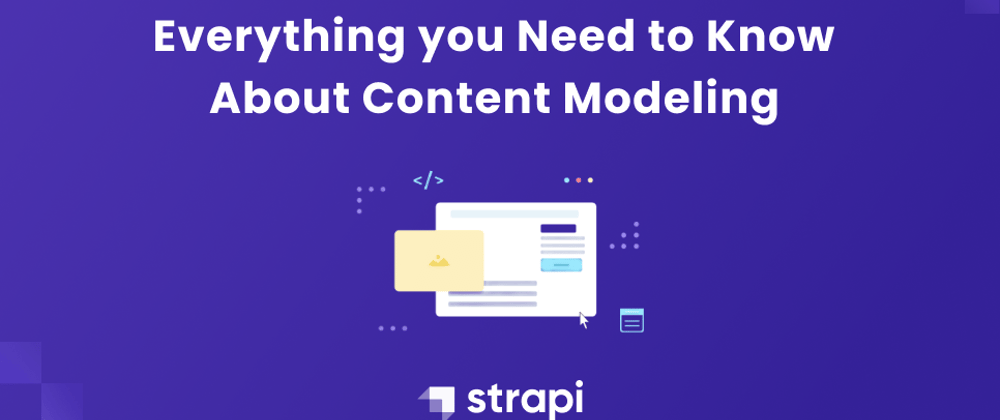In a world of advancing technology, customers are consuming content in more ways than ever. With smartphones, digital assistants, and IoT devices presenting new avenues for content consumption, users are demanding a content experience optimized for the devices they use.
That means that your organization’s content needs to be flexible, responsive, and agile enough to serve customers through multiple channels.
Content modeling helps your organization to clarify its content creation needs with a logical layout that guides content creation in a way that it can be presented in several different mediums.
In this post, you’ll learn what content modeling is and how to build a flexible content model that serves your current and future content needs.
What Is a Content Model?
A content model documents the content types and relationships in your organization. It helps you to determine the purpose of each piece of content, and how it can be used and reused as it moves through different channels.
Content model creation encourages collaboration between all content stakeholders, including information architects, developers, and content authors, as they work together to determine how to use the organization’s content more effectively.
Targeting Content to Different Mediums
Traditional content management systems like WordPress create and present content through a single medium, usually a web page. Because content is closely coupled to the front-end, it’s harder to reuse on other platforms.
Content modeling is only concerned with defining the content and its relationships, not how it is presented. Content is abstracted into separate components that can be used independently or combined to be displayed in different styles or layouts.
A content model is commonly represented as a diagram that shows the main content types and relationships. The diagram below represents a book publishing company with content types that include books, promotional blog posts and podcasts, and book signing events.
Reusable attributes would include a Person attribute that represents an author of a blog post, ebook or podcast, or a speaker at an event.
Planning, Replicating, and Collaborating to Build Content Experiences
Plan: Content models make it easier for organizations to design and implement multiple digital solutions from the same content, from websites, and mobile applications to menu boards and signage.
Replicate: Content models don’t target a specific presentation layer, making it easier to replicate and move data from one platform to another. Models can be customized, reused, and displayed in different formats to meet your target audience on whatever device they use.
Collaborate: With a content model, new team members or content consumers can get up to speed with the organization’s content architecture. It also fuels productive collaboration between content stakeholders ensuring that everyone involved in the content creation process is on the same page.
Limitations of Content Modeling
The more you abstract content into distinct types, the more steps you create for content creators. Going too deep can make the content model overly complicated and cumbersome.
Decide where you need to trade off flexibility for ease of use. Whether you define data as a field, component or simply an attribute should be based on the content needs of the organization and the end users.
Atomic Content Structure
Atoms are the building blocks of matter. They join to form molecules which then form the objects, materials, and compounds around us. The Greek form of the word means indivisible as an atom was once thought to be the smallest thing in the universe and could not be divided.
The atomic content structure follows the same principle. Content is broken down into its smallest identifiable entity called a field. Fields are the “atoms,” or the building blocks from which you create content.
In content modeling, atomic content is the dynamic combination of different content components displayed in a presentation format.
Why Don’t Traditional CMS and Content Coupling Support the Composable Approach?
A traditional CMS is built for a single specific presentation layer and content is tightly coupled to the front end of the system. There is no defined data model and content and presentation are stored together in the same dataset in an unstructured format (think HTML/CSS page or a Word document).
This one-to-one relationship makes it difficult to serve the same content to other devices and platforms. Since content can’t be separated from presentation, it can’t be broken down to support the composable approach.
The composable approach defines content types, breaks them down into components, and maps their relationship to other content types. Content can be assembled to best suit the targeted delivery platform, making it easier to re-use in varying scenarios.
Advantages of Using a Headless CMS to Work with Composable Content
A headless content management system decouples content from its presentation layer by separating the head (presentation layer) from the body (content). It’s a content-only backend repository that supports omnichannel content delivery i.e. it lets you deliver content to multiple channels or front-ends.
With headless CMS, you can use composable content to create as many heads as you need to deliver your content to multiple presentation layers on different platforms through API calls. A Headless CMS provides your organization with a single content source from which components can be assembled to publish content through multiple channels.
The Common Components of a Content Model
A content model is created using several components. Let’s look at the most common ones.
Fields represent a single item of data. They are the building blocks of atomic content structure and are the basic reusable structures of the content model. Strapi supports various types of data fields, including Text, JSON, Media, Boolean, Rich Text, and an array of numeric options.
Components are a combination of two or more fields that can work together as a unit. Components can be used to create reusable sets of fields and nested into other components. Strapi provides non-repeatable components, a combination of fields that can only be used once and repeatable components are used to create multiple component entries with the same combination of fields.
Dynamic Zones are a combination of components that can be added to content types to create a flexible content structure. They can be created from existing components or new ones and rearranged as needed by the user.
Single-Type content has one intended purpose. Single types are useful for creating one-off content that has a unique content structure like homepages, menus, about pages, or SEO settings.
Collection Types let you define the structure of your content and can contain multiple fields like Text, Number, JSON, Media, etc. Multiple entries can be created for each available collection type and can be used to repeat the same type of content e.g. blog posts, products, users, etc.
How to Build a Content Model
Almost 90% of top B2B marketers prioritize customer informational needs over the organization’s promotional message. They know that the best content is built around the customer’s needs.
That’s why your content model should be designed to create an optimal customer experience. Think about the kind of content you want to deliver and how it can guide and inform your customer’s journey. It should enhance usability, enable easy navigation, and encourage customer engagement.
Use a content-first approach to provide compelling content to your target audience, giving them the information they are looking for and the answers to their questions. The content-first approach helps your organization deliver the right content to your customers, in the right place and at the right time.
How to Plan Flexible Content Models
To create a flexible content model, determine the content your organization needs. Collaborate with all stakeholders, including developers and marketers, to inventory your current content. Decide what content you want to keep or remove and the content you need for the future.
Next, identify the content types and fields you need to create to optimize the way your content is used. Create components for any content that is reused across the entire organization. Consider common content structures like buttons, links, and logos that remain similar from project to project.
Also consider content that remains constant across all channels, customized for different audiences or content like CTAs that need to be optimized.
Finally, look for links that indicate relationships between your content types. Is it a one-to-one, zero-to-many, or many-to-many relationship? Relationships can be applied to the content model to add structure and meaning.
Common Goals For Your Content Model
A robust content model should be specific, target important customer and business needs, and make content flexible so that it can adapt to future needs.
Common goals include:
- Helping customers benefit from flexible just-in-time information
- Access specific content that is relevant to the customer
- Agile reuse of content in similar and different scenarios
- Consistent content delivery
- Flexible content that can address future customer and business needs
Setting specific goals helps the organization to make the best use of its content resources.
Conclusion
In this guide, you’ve looked at what content modeling is, and learned the best way to create a flexible content model using an atomic content structure and a composable approach. You’ve also seen how a headless CMS supports flexible content models to provide the freedom to serve content to any front-end presentation layer.
Strapi simplifies content modeling to help you define, structure, and create content models and APIs. With its atomic content structure, you can easily define and reuse the standard components you need to serve your customers through multiple content channels.







Top comments (0)